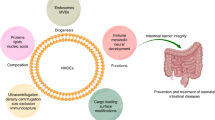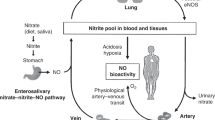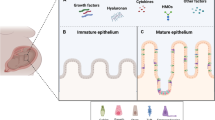Abstract
Breast milk reduces the incidence of necrotizing enterocolitis (NEC). BH4 is a cofactor for endothelial NOS (eNOS). Reduced BH4 levels, or its oxidation to dihydrobiopterin (BH2), uncouple eNOS resulting in formation of reactive oxygen species (ROS) that have been implicated in the pathogenesis of NEC. We evaluated colostrum and mature breast milk, as well as infant formula, BH4 and BH2 content. In addition, we tested the BH4 effect on the newborn rat mesenteric arterial vascular tone. BH4 and BH2 content increased 3-fold in mature breast milk, when compared with colostrum (p < 0.01), without a change in their ratio. Infant formula had a negligible BH4 content and lower biopterins ratio, when compared with breast milk. eNOS is the predominant synthase isoform in newborn rat mesenteric arteries. In the presence of BH4, mesenteric arteries contracted less to thromboxane A2 analog U46619 (p < 0.01) and this effect was abolished following eNOS inhibition. BH4 (10−6 M) vasorelaxed the newborn rat mesenteric arteries. We conclude that when compared with infant formula, breast milk has a high BH4 content that increases as breastfeeding continues. Given its mesenteric arterial vasorelaxing effect, BH4 may play an important role in the reduced NEC incidence among breast-fed infants.
Similar content being viewed by others
Log in or create a free account to read this content
Gain free access to this article, as well as selected content from this journal and more on nature.com
or
Abbreviations
- BH2:
-
7,8 dihydrobiopterin
- BH4:
-
tetrahydropterin
- eNOS:
-
endothelial NOS
- nNOS:
-
neuronal NOS
- NEC:
-
necrotizing enterocolitis
References
Lambert DK, Christensen RD, Henry E, Besner GE, Baer VL, Wiedmeier SE, Stoddard RA, Miner CA, Burnett J 2007 Necrotizing enterocolitis in term neonates: data from a multihospital health-care system. J Perinatol 27: 437–443
Barlow B, Santulli TV 1975 Importance of multiple episodes of hypoxia or cold stress on the development of enterocolitis in an animal model. Surgery 77: 687–690
Chan KL, Hui CW, Chan KW, Fung PC, Wo JY, Tipoe G, Tam PK 2002 Revisiting ischemia and reperfusion injury as a possible cause of necrotizing enterocolitis: role of nitric oxide and superoxide dismutase. J Pediatr Surg 37: 828–834
Clark DA, Fornabaio DM, McNeill H, Mullane KM, Caravella SJ, Miller MJ 1988 Contribution of oxygen-derived free radicals to experimental necrotizing enterocolitis. Am J Pathol 130: 537–542
Yang YM, Huang A, Kaley G, Sun D 2009 eNOS uncoupling and endothelial dysfunction in aged vessels. Am J Physiol Heart Circ Physiol 297: H1829–H1836
Matsubara Y, Gaull GE 1985 Biopterin and neopterin in various milks and infant formulas. Am J Clin Nutr 41: 110–112
D'Souza A, Fordjour L, Ahmad A, Cai C, Kumar D, Valencia G, Aranda JV, Beharry KD 2010 Effects of probiotics, prebiotics, and synbiotics on messenger RNA expression of caveolin-1, NOS, and genes regulating oxidative stress in the terminal ileum of formula-fed neonatal rats. Pediatr Res 67: 526–531
Whitehouse JS, Xu H, Shi Y, Noll L, Kaul S, Jones DW, Pritchard KA Jr Oldham KT, Gourlay DM 2010 Mesenteric nitric oxide and superoxide production in experimental necrotizing enterocolitis. J Surg Res 161: 1–8
Tegeder I, Costigan M, Griffin RS, Abele A, Belfer I, Schmidt H, Ehnert C, Nejim J, Marian C, Scholz J, Wu T, Allchorne A, Diatchenko L, Binshtok AM, Goldman D, Adolph J, Sama S, Atlas SJ, Carlezon WA, Parsegian A, Lotsch J, Fillingim RB, Maixner W, Geisslinger G, Max MB, Woolf CJ 2006 GTP cyclohydrolase and tetrahydrobiopterin regulate pain sensitivity and persistence. Nat Med 12: 1269–1277
Bradford MM 1976 A rapid and sensitive method for the quantitation of microgram quantities of protein utilizing the principle of protein-dye binding. Anal Biochem 72: 248–254
Alemany CA, Oh W, Stonestreet BS 1997 Effects of nitric oxide synthesis inhibition on mesenteric perfusion in young pigs. Am J Physiol 272: G612–G616
Crissinger KD, Granger DN 1989 Mucosal injury induced by ischemia and reperfusion in the piglet intestine: influences of age and feeding. Gastroenterology 97: 920–926
Qu XW, Wang H, Rozenfeld RA, Huang W, Hsueh W 1999 Type I nitric oxide synthase (NOS) is the predominant NOS in rat small intestine. Regulation by platelet-activating factor. Biochim Biophys Acta 1451: 211–217
Petersson J, Schreiber O, Steege A, Patzak A, Hellsten A, Phillipson M, Holm L 2007 eNOS involved in colitis-induced mucosal blood flow increase. Am J Physiol Gastrointest Liver Physiol 293: G1281–G1287
Belik J, Pan J, Jankov RP, Tanswell AK 2004 A bronchial epithelium-derived factor reduces pulmonary vascular tone in the newborn rat. J Appl Physiol 96: 1399–1405
Qu XW, Thaete LG, Rozenfeld RA, Zhu Y, De Plaen IG, Caplan MS, Hsueh W 2005 Tetrahydrobiopterin prevents platelet-activating factor-induced intestinal hypoperfusion and necrosis: role of neuronal nitric oxide synthase. Crit Care Med 33: 1050–1056
Crissinger KD, Burney DL 1991 Postprandial hemodynamics and oxygenation in developing piglet intestine. Am J Physiol 260: G951–G957
Dhondt JL, Delcroix M, Farriaux JP 1982 Unconjugated pteridines in human milk. Clin Chim Acta 121: 33–35
Iizuka T, Sasaki M, Oishi K, Uemura S, Koike M, Minatogawa Y 1997 Nitric oxide may trigger lactation in humans. J Pediatr 131: 839–843
Crabtree MJ, Tatham AL, Al-Wakeel Y, Warrick N, Hale AB, Cai S, Channon KM, Alp NJ 2009 Quantitative regulation of intracellular endothelial nitric-oxide synthase (eNOS) coupling by both tetrahydrobiopterin-eNOS stoichiometry and biopterin redox status: insights from cells with tet-regulated GTP cyclohydrolase I expression. J Biol Chem 284: 1136–1144
Sawabe K, Saeki Y, Ohashi A, Mamada K, Wakasugi KO, Matsuoka H, Hasegawa H 2009 Tetrahydrobiopterin in intestinal lumen: its absorption and secretion in the small intestine and the elimination in the large intestine. J Inherit Metab Dis 32: 79–85
Ozkan H, Oren H, Erdag N, Cevik N 1994 Breast milk versus infant formulas: effects on intestinal blood flow in neonates. Indian J Pediatr 61: 703–709
Lang JA, Holowatz LA, Kenney WL 2009 Local tetrahydrobiopterin administration augments cutaneous vasoconstriction in aged humans. J Physiol 587: 3967–3974
Lang JA, Holowatz LA, Kenney WL 2010 Localized tyrosine or tetrahydrobiopterin supplementation corrects the age-related decline in cutaneous vasoconstriction. J Physiol 588: 1361–1368
Henderson G, Craig S, Brocklehurst P, McGuire W 2009 Enteral feeding regimens and necrotising enterocolitis in preterm infants: a multicentre case-control study. Arch Dis Child Fetal Neonatal Ed 94: F120–F123
Author information
Authors and Affiliations
Corresponding author
Additional information
Supported by an operational grant from the Canadian Institutes of Health and Research, no. MOP 93710 [J.B.].
Rights and permissions
About this article
Cite this article
Weinmann, A., Post, M., Pan, J. et al. Tetrahydrobiopterin Is Present in High Quantity in Human Milk and Has a Vasorelaxing Effect on Newborn Rat Mesenteric Arteries. Pediatr Res 69, 325–329 (2011). https://doi.org/10.1203/PDR.0b013e31820bc13a
Received:
Accepted:
Issue date:
DOI: https://doi.org/10.1203/PDR.0b013e31820bc13a
This article is cited by
-
Phenylketonuria
Nature Reviews Disease Primers (2021)
-
Intestinal microbiota as a tetrahydrobiopterin exogenous source in hph-1 mice
Scientific Reports (2017)
-
Packed red cell transfusions alter mesenteric arterial reactivity and nitric oxide pathway in preterm lambs
Pediatric Research (2013)



